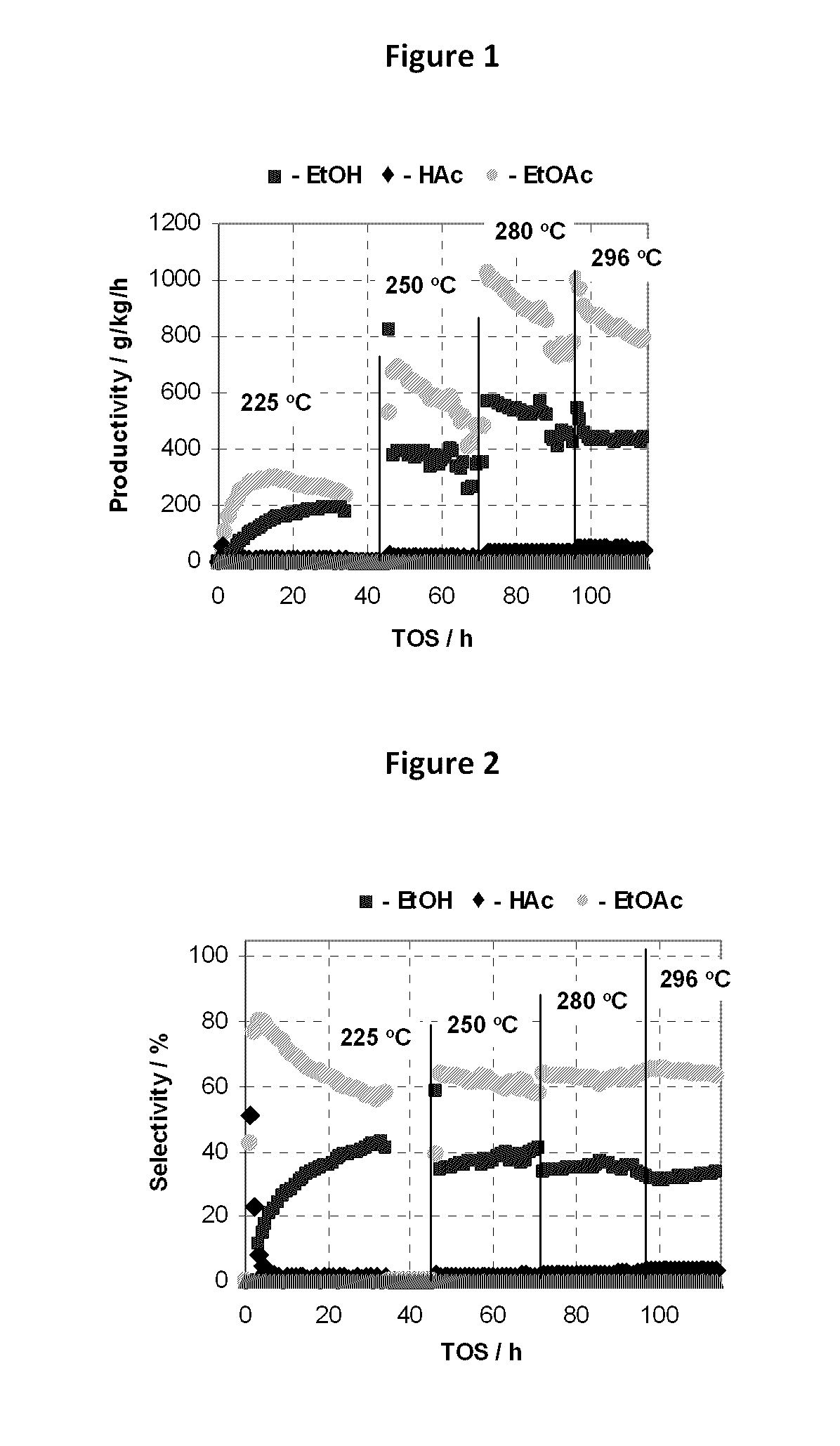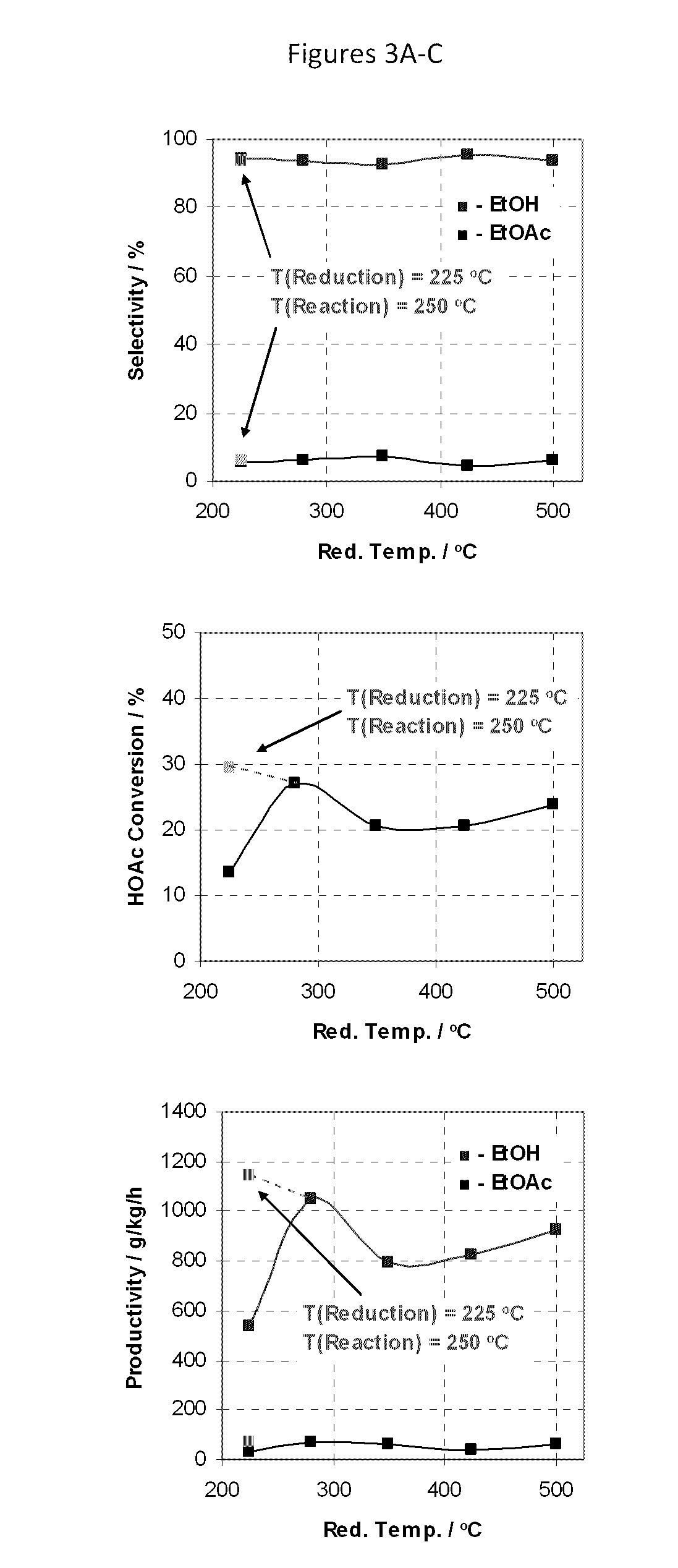Catalyst for gas phase hydrogenation of carboxylic acids having a support modified with a reducible metal oxide
a technology of carboxylic acid and catalyst, which is applied in the direction of metal/metal-oxide/metal-hydroxide catalyst, physical/chemical process catalyst, bulk chemical production, etc., can solve the problems of prohibitively expensive and/or non-selective catalysts, and affecting the production efficiency of ethyl acetate, etc., to achieve the effect of preventing excessive loss of activity and selectivity
- Summary
- Abstract
- Description
- Claims
- Application Information
AI Technical Summary
Benefits of technology
Problems solved by technology
Method used
Image
Examples
example 1
[0164]In a tubular reactor made of stainless steel, having an internal diameter of 30 mm and capable of being raised to a controlled temperature, there are arranged 50 ml of catalyst prepared as described in catalyst preparation C above. The length of the combined catalyst bed after charging was approximately about 70 mm.
[0165]The feed liquid was comprised essentially of acetic acid. The reaction feed liquid was evaporated and charged to the reactor along with hydrogen and helium as a carrier gas with an average combined gas hourly space velocity (GHSV) of 2500 hr−1 at a temperature of 250° C. and pressure of 100 psig. The feed stream contained a mole percent of acetic acid from about 6.1% to about 7.3% and mole percent of hydrogen from about 54.3% to about 61.5%. A portion of the vapor effluent from the reactor was passed through a gas chromatograph for analysis of the contents of the effluents. The selectivity to ethanol was 93.4% at a conversion of acetic acid 85%.
[0166]The catal...
example 2
[0167]The catalyst utilized was 1 weight percent platinum and 1 weight percent tin on calcium silicate prepared in accordance with the procedure of Example C.
[0168]The procedure as set forth in Example 1 is substantially repeated with an average combined gas hourly space velocity (GHSV) of 2,500 hr−1 of the feed stream of the vaporized acetic acid and hydrogen at a temperature of 250° C. and pressure of 22 bar. A portion of the vapor effluent is passed through a gas chromatograph for analysis of the contents of the effluents. The acetic acid conversion is greater than 70% and ethanol selectivity is 99%.
example 3
[0171]The procedure of Example 2 was repeated using a variety of catalysts at a temperature as set forth in Table 2 setting forth the percentages of carbon monoxide (CO), acetaldehyde (AcH) and ethane in the products as well as the selectivity for, and productivity of, ethyl acetate (EtOAc); ethanol (EtOH) as well as the percentage conversion of acetic acid (HOAc) (MCD p. 4). Throughout, the mole ratio of H2 to acetic acid was maintained at 5:1. F or convenience, the results of examples 1 and 2 and comparative example 1 are also included in Table 2. Generally speaking when it is desired to produce ethanol as the primary product, selectivities to ethanol above 80% or so are desirable; selectivities to ethyl acetate of less than 5% are desired, preferably less than 3%.
[0172]
TABLE 2ReactorAcHEthaneEtOAcEtOHEtOAcEt OHHOAcCP#CatalystTemp (° C.)CO%%%%g / kg / hg / kg / hConv. %KSiO2—PtxSn1−x; x = 0250————————LSiO2—PtxSn1−x; x = 0.25250———415947368328MSiO2—PtxSn1−x; x = 0.50250———2674788221773NSiO...
PUM
| Property | Measurement | Unit |
|---|---|---|
| mole ratio | aaaaa | aaaaa |
| pressure | aaaaa | aaaaa |
| temperature | aaaaa | aaaaa |
Abstract
Description
Claims
Application Information
 Login to View More
Login to View More - R&D
- Intellectual Property
- Life Sciences
- Materials
- Tech Scout
- Unparalleled Data Quality
- Higher Quality Content
- 60% Fewer Hallucinations
Browse by: Latest US Patents, China's latest patents, Technical Efficacy Thesaurus, Application Domain, Technology Topic, Popular Technical Reports.
© 2025 PatSnap. All rights reserved.Legal|Privacy policy|Modern Slavery Act Transparency Statement|Sitemap|About US| Contact US: help@patsnap.com



